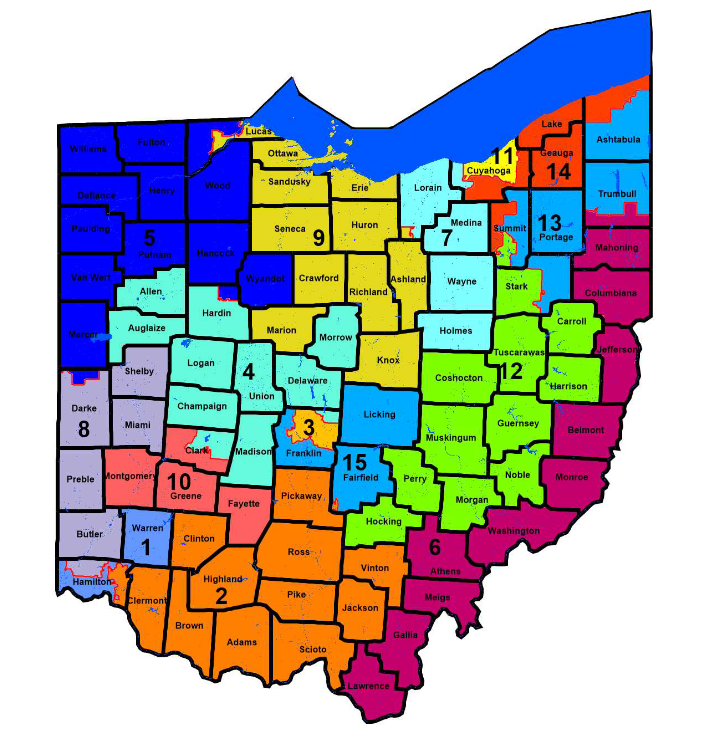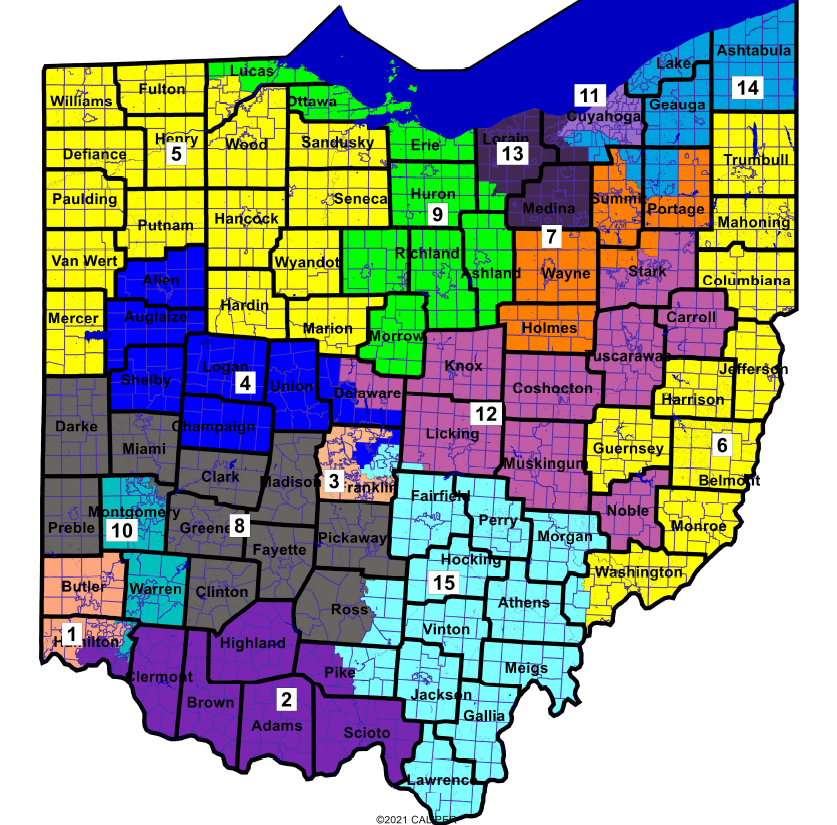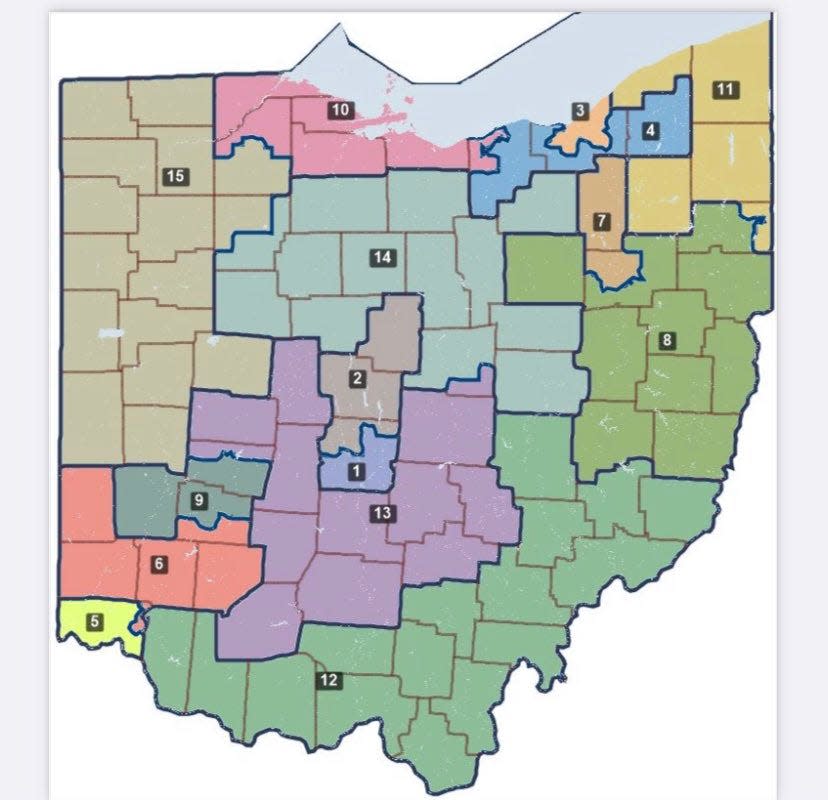Third congressional map plan, by Akron Democrat Vernon Sykes and Kenny Yuko, gets no traction amid GOP redistricting proposals
- Oops!Something went wrong.Please try again later.
EDITOR'S NOTE: This article has been updated with further information, including details of the redistricting plan submitted by Democratic state Rep. Vernon Sykes of Akron and state Sen. Kenny Yuko of Richmond Heights.
Republican leaders in the Ohio House and Senate released separate plans Wednesday to redraw the state's 15 U.S. congressional districts for 2022, down from 16 after Ohio lost a seat following the 2020 census.
Devised by the legislature after a redistricting commission failed to act, the proposed maps would need to be reconciled and, if they withstand what's sure to be a legal challenge, would last four years unless enough Democrats supported them.
Proposed maps: Ohio Republicans propose congressional district maps advantaging the GOP
House map: See it here
Senate map: See it here
That's unlikely as the Republican-dominated Statehouse has crafted maps that would forecast ongoing GOP control of the legislature and the state's congressional delegation. A third map is getting no traction in the Senate after its release in late September by Democrats Vernon Sykes of Akron and Kenny Yuko of Richmond Heights.
The Democrats' plan, unlike the official House and Senate proposals, would not only keep Akron intact but all of Summit County, which would join the northwest corner of Stark County in a compact new district that connects voters in Akron and Canton.
Interactive maps for each plan are at:
https://bit.ly/3bJWipD for the House version.
https://bit.ly/3nXZ5B9 for the Senate version.
https://bit.ly/3q7mvqv for the Yuko/Sykes plan.
Summit County is currently home to four congressional districts with U.S. representatives who all live somewhere else. Neither the House nor the Senate maps would leave Summit County intact. The House version is the only of the three that splits Akron.
While Summit County voted for Joe Biden last year and currently has two districts controlled by Democrats (and two by Republicans), the Senate and House versions share a vision for GOP dominance of local congressional races, according to mapping software that calculates partisan lean based on voter activity.
Statewide, the House version trims what are currently three reliably blue districts down to two, leaving few that would look competitive in 2022. The Senate version also keeps two blue districts around Cleveland and Columbus, but creates two more where registered Republicans would outnumber registered Democrats by only a percentage point or two.
But even four districts out of 15 (27%) is out of whack in a state with a Democrat in the U.S. Senate and 45% of voters casting ballots for Biden last year. The closest approximation to the will of the voters would be seven seats with more registered Democrats and eight with more registered Republicans.
That was the thrust of Issue 1, a constitutional amendment crafted by the legislature and passed overwhelmingly by 75% of Ohio voters in 2018. The constitution now requires that how the new districts "favor each political party shall correspond closely to the statewide preferences of the voters of Ohio" in state and federal elections over the past 10 years.
"These people don’t give a [expletive] about what the constitution says. And you can quote me on that," Tom Bevan, chair of the Summit County Democratic Party, said.
"The more they go out on a limb, the less likely our Supreme Court is going to accept this [as constitutional]," he said.
The House plan

Under the House proposal, Akron would be divided into two districts with one stretching into Portage, Ashtabula and Trumbull counties, while another extends into several Appalachian counties south of the city. Both districts would favor Republicans.
"I've heard that Hocking Hills is gorgeous, but to add that to the Akron map is just insane," said Rep. Tavia Galonski, who would find herself living in a district with 10 rural counties to the south.
"How is that keeping a community together?" she asked. "What it does is stretch a community so far out of bounds that no one feels a sense of community. And I can't understand that."
Summit County would drop from four to three congressional districts total under the House proposal. Like today, none would be wholly contained in Summit County, which has a population of about 540,000, while the apportionment process slices Ohio into 15 chunks of more than 760,000 voters each. (By comparison, the populations of Portage and Summit counties combined are about 700,000.)
A new 12th District would swing into Summit County from the south, pulling West Akron and Sherbondy Hill, the two Akron neighborhoods with the highest concentration of Black residents, into a solidly Republican district that stretches down to Hocking County. In this sprawling district stretching from Appalachia to the Rubber City, only Stark and Summit are split while the other 10 counties, all rural, would be left intact.
The eastern half of the county would be incorporated into a new 13th Congressional District. This would be the most competitive of the three proposed districts in Summit County, though Republicans would still hold a 50.4% to 47.1% advantage over Democrats, according to Beacon Journal mapping on Dave’s Redistricting.
Republicans would hold a 17-point advantage over Democrats in the 12th and, covering western Summit County, a 7.8-point advantage over Democrats in the 14th, again according to voting data populated by Dave’s Redistricting.
The Senate plan

The Senate proposal released shortly after the House plan on Wednesday takes one less swipe at Summit County, creating only two districts, with Akron undivided in one of them.
The northeastern edge of the county, including Hudson, Twinsburg, Northfield, Macedonia, Reminderville and a piece of Stow, would join the new 14th Congressional District: all of Ashtabula, Lake and Geauga counties, Ravenna, Kent and everything north of them in Portage County; and the southern suburbs of Cleveland in Cuyahoga County.
This district would favor Republicans by 9 points, according to Dave's Redistricting.
The other district would include everything else in Summit County, including all of Akron, in a new 7th Congressional District. With about a 5-point GOP advantage, the district would include all of Wayne County and the northern half of Holmes County; Portage County communities east and south of Ravenna; and several Stark County communities, including Jackson, Plain, Lake and Lawrence townships and Canal Fulton.
The Yuko/Sykes plan

The proposal offered by Senate Democrats doesn't split Summit County or most of Ohio's major cities, including Akron, Cincinnati, Cleveland, Dayton, Toledo and Youngstown. The northwest corner of Columbus is spun off with the northern portion of Franklin County and the two counties directly to the north.
“In the spirit of promoting fairness, our map takes into consideration all criteria required by the Ohio Constitution,” Sykes told the Senate Local Government and Elections Committee on Wednesday about their plan. “Our map keeps communities together and does not unduly favor or disfavor a political party. It also complies with the spirit of the constitutional reforms to end gerrymandering that were overwhelmingly supported by Ohio voters in 2018.”
The Yuko/Sykes plan, compared to either plan proposed by Republicans in the House or Senate, is more compact, gives minority voters more electoral punch and splits communities the least, according to objective scoring by Dave's Redistricting, an online mapping tool that Republicans have used to broadcast previous plans.
The Democrat-drawn map, while landing in the middle of the other two plans based on competitiveness, would shake things up, creating more districts where no current member of Congress already lives. While it's not a constitutional requirement for candidates to live in their U.S. House districts, the Republican plan in the House has three districts with no incumbent compared to two in the Senate plan and five in the Yuko/Sykes plan.
One of those five happens to be the proposed 7th District that connects Akron and Canton.
Jessie Balmert of the Ohio Bureau contributed to this report. Reach Doug Livingston at dlivingston@thebeaconjournal.com or 330-996-3792.
This article originally appeared on Akron Beacon Journal: Congressional redistricting maps slice Akron and Summit County


